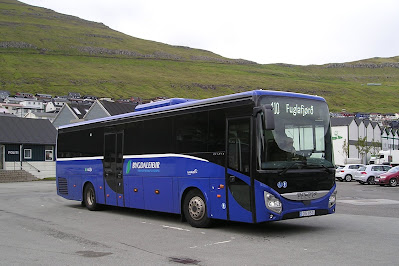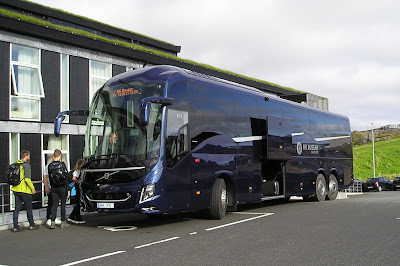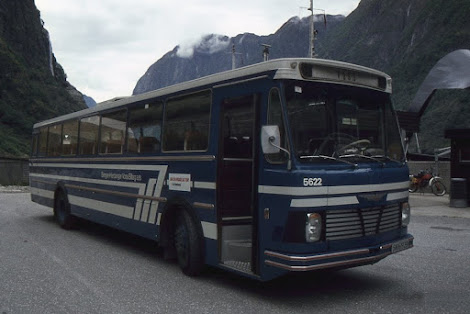In the Hemsdalsbilene depot at Hemsedal, Volvo with Vest Buss body. Hemsedal is a small town with a permeant population of around 2000 swollen by a large influx of tourists. The town is home to Norway’s second largest ski resort and a popular hiking/climbing resort in summer. With our first brand-new car sitting in the drive, a decision was needed: where should we go on holiday? Out of nowhere came the answer - Norway. Being 1985, this was a relatively simple drive. Head north to Newcastle-upon-Tyne, board the Norway Lines ferry to Bergen and head east with our goal being Gol in Hallingdal district midway between Oslo and Bergen. Gol was chosen for its central location whether using road, rail and, as it transpired, bus, plus a rather attractive self-catering log cabin. Gol lies in the Hallingdal valley 290 kms from Bergen on highway 7, with a population around 2400 at the time. Hallingdal district also includes the villages of Flå, Nes, Hemsedal, Ål and Hol, all of which were served by a network of regular bus services.
Despite reassurances from Norwegian tourist information that English was widely spoken, which might have been the case in the more popular tourist destinations, in Gol and the surrounding area English was very much the preserve of the young, and fortunately for us, the staff in the tourist information office.
Without doubt the public transport highlight of the holiday was a suggestion from a tourist office employee that we purchase a one-day multi-modal ticket for a round trip Gol-Aurland-Flam-Myrdal-Gol.
An early morning start from Gol towards Geilo found us as the only two passengers aboard a Hallingdal Billag DAF with Repstads Brothers body. Before too long, the driver indicated we were to alight at a road junction close to Hagafoss. No one else waiting, no obvious houses around and no onward connection in sight, a few nail-biting minutes ensued. Out of nowhere came another Hallingdal Billag bus: this time a Volvo with one other passenger already on board and it took us on a beautiful journey alongside lakes with mountains in the background and a surprisingly comfortable ride considering the road had no tarmac surface. It is worth noting that a spare wheel was carried, attached to the outside of the boot. Eventually we made our first and, as it turned out, only stop. Not to pick up passengers, but a refreshment stop at the ‘Trolls Café’. Fifteen minutes later we were back on the road, travelling through narrow tunnels with rough bare rock sides and roofs and virtually no lighting. After many hairpin bends and a steep descent we arrived in the town of Aurland, located on Aurlandsfjord, where the bus pulled in adjacent to the ferry departure point. This was the last bus journey of the day as from here we boarded a ferry to Flåm, along with a number of German tourists travelling on Neoplan Ciyliner. Our onward journey from Flåm was aboard the famous Flåm Railway to Myrdal before completing our circular trip aboard the mainline Bergan-Oslo train service. However, those seeking an onward westerly journey from Flåm were meet by a waiting BHV bus service to Voss.
Sadly, a few days later, with the sun shining at 3am, we would start the journey home, needing to be at the Eidfjorden ferry for the 6am departure, and joining the Norway Lines midday ferry departure at Bergen for Newcastle via Stavanger.
Today, there are eight local bus routes serving Gol township, plus a ski service and three express coach routes, and whilst the railway station remains open, it is no longer staffed - a mere shadow of its 1985 status when it was a fully staffed freight/distribution hub. The local bus network is coordinated by Brakar, formed in 2009 by the regional council and several local councils, and today it is 100% owned by Viken county municipality and provides twenty-four local bus services in the Hallingdal area.
BVH Volvo B58-60 with Arna body, photographed at Flam ferry terminal about to depart for Voss. A prime example of coordinated transport, the service delivering/collecting passenger from the Aurlandsfjord ferry.
Bergen-Hardanger-Voss Billag A / S (BHV) was formed in 1978 from a merger between three well established bus companies who could trace their roots back to the 1920s and 30s. BHV was taken over in 1997 by Hardanger Sunnhordlandske Dampskipsselskap (HSD) which later merged with Gaia Trafikk to form Tide ASA .
BHV operated bus routes on the sections Bergen – Hardanger over Kvamskogen (in conjunction with HSD-Bilane), Bergen – Voss over Dale, and the section Bergen – Tysse – Eikelandsosen, as well as a route Bergen – Aurland which was the company's longest, 210 km.

Sogn Billag, Volvo with Vest body arriving into Gol. Sogn Billag was established in 1936 in Sogndal and continues in business although now owned by Nettbuss. In 1982, three years before our visit, Sogn Billag acquired Gol-Lærdal-Maristubilene Ltd. (GLM) based in Lærdal, 113km west of Gol, who operated eight buses, five trucks and two trailers and had co-operated with Firda Billag and Sogn Billag on a route between Førde, Sogndal, Lærdal and Gol to connect with the train service between Oslo and Bergen.
Sogn Billag, Volvo with Vest Buss body, on torbuss duties. Waiting for the early morning Eidfjorden ferry. Today the ferry service has been superseded by the Hardanger Bridge.
About to depart Gol for Hemsedal, a journey of 30km, is Hemsdalsbilene, Volvo with Vest Buss body. Today this is service 360 operating twice a day.
Local traffic calming measures delay Hemsdalsbilene, Volvo with Vest Buss body on route to Hemsdal.
Hemsdalsbilene, Volvo with Vest Buss part freight body, loading in Gol Station for a service to Hemsedal. Vest Buss built its first bodywork in 1967. In 2002 Busscar acquired a major stake, later selling out. The final bus bodies were built in 2011 although the company continues to trade as an Iveco distributor.
Hallingdal Billag (HB) was founded in 1972 following a merger between Hol Bilselskap AS and P / L Ål Rutebillag, later acquiring Fossgård Bilruter. At its formation, the company had 20 buses, 5 combined buses, 10 trucks and 4 trailers. By 1978 this had increased to 28 buses, 15 trucks, 4 combined vehicles and 4 trailers. In 1974, eleven routes were operated, plus one route operated jointly with Aurland Kommunale Rutebilar.
May 1987 saw a summer only express between Bergen - Voss - Aurland - Ål - Oslo established. The route was a collaboration between Bergen-Hardanger-Voss Billag (BHV), Aurland Kommunale Rutebilar , Hallingdal Billag and NSB Krøderenrutene. It was not a great success and was closed down after the 1994 summer season.
In the late 1980s, the company experienced financial problems that persisted for several years. On 1 June 2002, Sogn Billag took over Hallingdal Billag, operating the 30 vehicles as a subsidiary, whilst Hallingfrakt A/S acquired the freight traffic. Eventually the business was absorbed into Nettbuss becoming Nettbuss Hallingdal Billag.
Hallingdal Billag A/S, Volvo with Arna body on route to Aurland, three passengers and the driver enjoy a scenic rest stop at the Trolls Café. It is worth noting the unsealed road surface, quite common in 1985, even for a main road such as this. This road linking Aurland with what is now the A7 was opened in the early 1970s. In 1974 the bus service became a joint operation between Hallingdal Billag and Aurland Kommunale Rutebilar.
Hallingdal Billag A/S DAF MB200 with Repstads Brothers body At Gol on route to Geilo at the start of the author’s long day trip to Flåm. Geilo is the largest town in the area 69km west of Gol with a population of just under 3000. The town sits astride highway 7 and is the focal point for an array of ski activities spread over a large part of the surrounding area.
Laying-over in Gol, Hallingdal Billag A/S, Volvo BB57 with Repstads Brothers body. In 1912 Gunnar and Edvard Repstad started a blacksmiths business in Lunde, Norway with the first bus bodies leaving the smithy in 1925, and between 1933 and 1980 the company continued to expand with the exception of the war years. The business went bankrupt in 1990 having produced about 5000 buses during its existence.
Hallingdal Billag A/S. Mercedes Benz with Arna body laying-over in Gol having come from Al, a small town 26km further west along the A7 with a population of 5000. Arna Busser A/S commenced bus body production in 1947 and eventually went bankrupt in 1997, the assets being acquired by Vest Buss.





















































